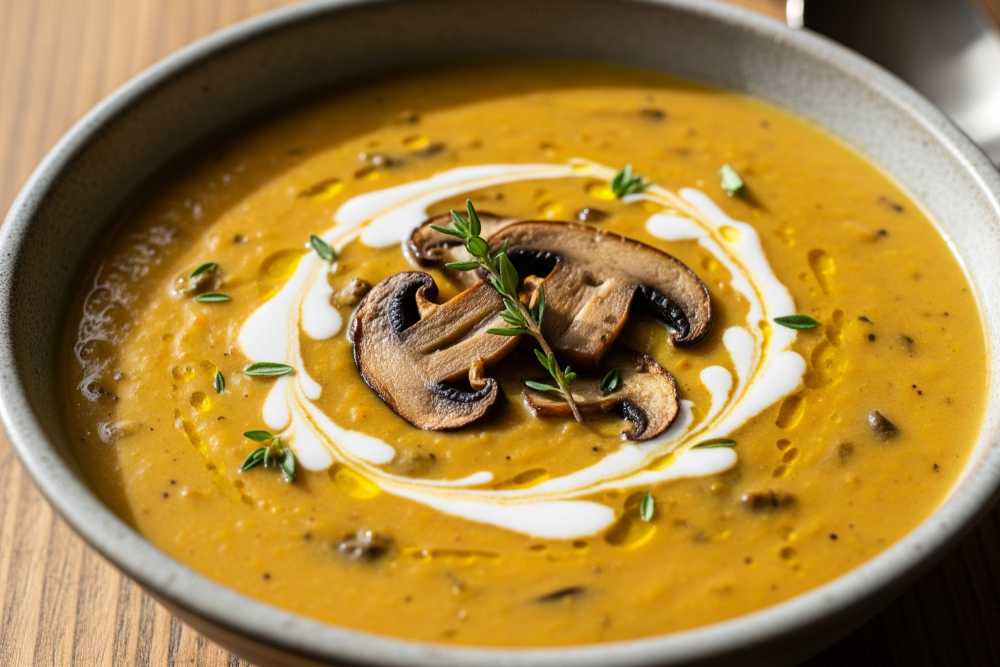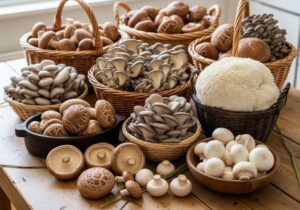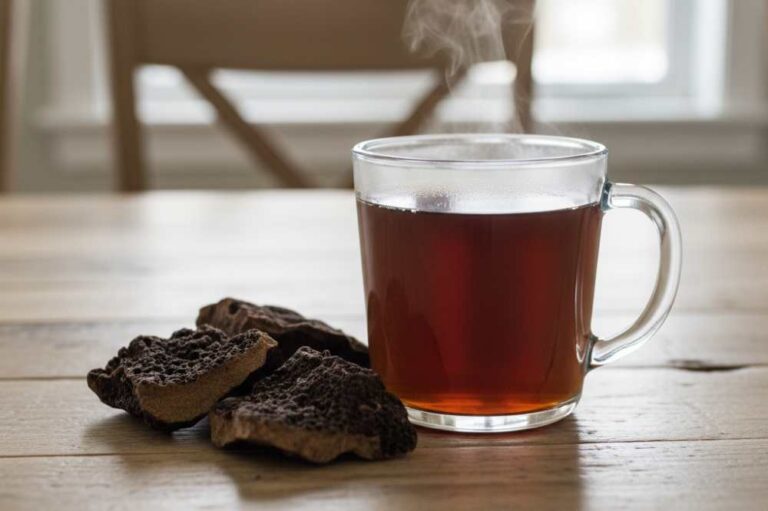Butternut squash and mushrooms are one of those rare combinations that feel like a happy accident turned culinary goldmine. I’ve made countless soups in my kitchen—some delicate, others bold—but this pairing? It strikes a balance that most plant-based dishes struggle to hit: comforting richness with layered depth.
Butternut squash brings that velvety, mellow sweetness we crave during colder months. Roast it right, and you unlock flavors far beyond what you’d get by simply boiling it. Mushrooms, on the other hand, are all about earthiness, umami, and savory backbone. Together, they create a soup that doesn’t need cream to feel indulgent.
Why Roasting Changes the Game
You could steam or boil your squash and mushrooms. You could. But you’d be missing out on everything that makes this soup more than just “nice.” Roasting is where the transformation happens—and I’m not overstating it.
Here’s what roasting does:
- It draws out the natural sugars in squash, creating those caramelized edges and nutty, slightly sweet depth.
- For mushrooms, roasting intensifies their umami and dries them out just enough to concentrate their flavor. You’re not getting watery fungi here—you’re getting a savory base note that carries the whole dish.
Scientifically, this is thanks to the Maillard reaction—a chemical reaction between amino acids and reducing sugars that occurs when food is browned. For mushrooms, that means a more savory, almost “meaty” profile. I’ve used this technique in restaurant kitchens and at home, and I’ll tell you now: nothing beats roasted mushrooms for soup stock depth—no bouillon cube can compete.
Even the squash benefits from this browning. According to a study on Cucurbita moschata (butternut squash), it is already naturally rich in carbohydrates and carotenoids. Roasting it amplifies both its nutritional value and flavor. You get a deeper color, a firmer texture, and a layered sweetness that doesn’t show up when it’s boiled or steamed.
List of Ingredients
Let’s break down what really makes this soup shine—because every component here has a role to play. And if you’re someone who shops intentionally, this section will help you make the best decisions when you’re gathering your ingredients.
Butternut Squash
Selecting the right butternut squash can make or break this recipe, and I learned this the hard way after several disappointing batches early in my cooking journey. A good butternut squash should feel heavy for its size—this indicates high moisture content and proper ripeness. The skin should be firm and matte, not glossy or soft.
Here’s a trick I picked up from a farmer’s market vendor: check the stem end. If it’s starting to soften or show dark spots, the squash is past its prime. The best specimens have a clean, dry stem end and make a hollow sound when tapped.
Mushrooms
I’ve been experimenting with different mushroom varieties for over a decade, and I can tell you that not all mushrooms are created equal when it comes to soup-making. Cremini
mushrooms provide a reliable earthiness with moderate umami, while shiitakes bring an almost meaty intensity that can sometimes overpower delicate squash.
My personal preference? A combination of cremini and oyster mushrooms. The oyster mushrooms have a subtle sweetness that complements the squash beautifully, while the cremini provides a solid umami foundation.
Never, and I mean never, soak mushrooms in water to clean them. Mushrooms are like little sponges, and waterlogged mushrooms will steam rather than caramelize, robbing you of that crucial Maillard reaction. Instead, use a damp paper towel or mushroom brush to gently remove any dirt. When slicing, aim for uniform pieces about ¼-inch thick—this ensures even cooking and prevents some pieces from burning while others remain undercooked.
Aromatics
I prefer garlic and shallots over regular onions for this soup because they have a more delicate, almost wine-like flavor that doesn’t compete with the squash’s natural sweetness. The key is to cook them until they’re translucent but not browned—you want them to meld into the background, providing depth without asserting their own personality.
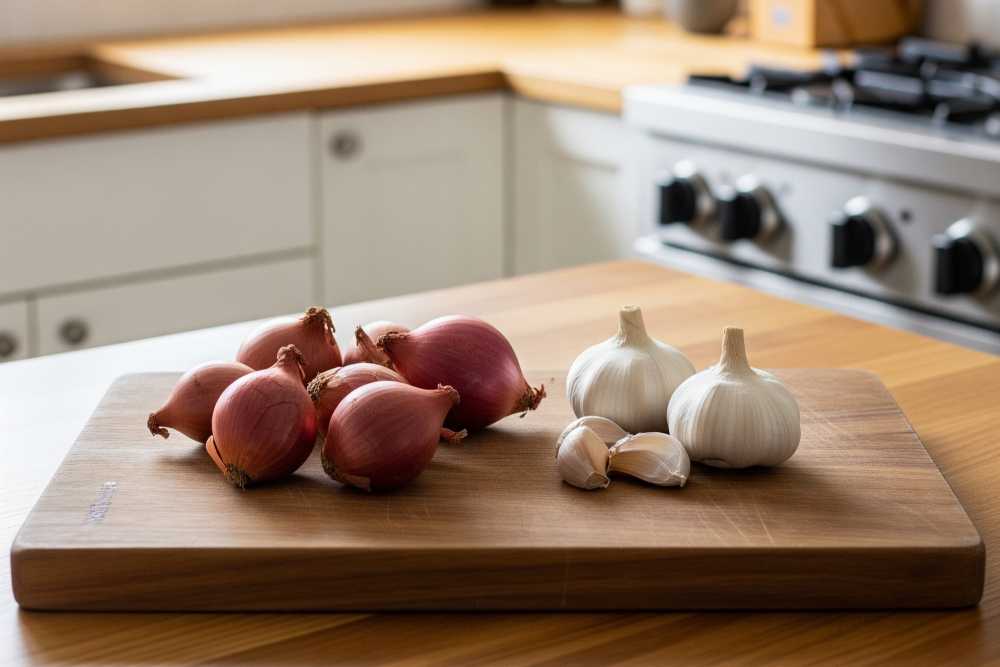
Plant-Based Creaminess
Full-fat coconut milk provides richness without the coconut flavor overpowering the soup (contrary to what many people fear). Cashew cream creates an incredibly silky texture but requires advance planning for soaking. Nutritional yeast might sound like an odd addition, but it adds a subtle depth that mimics the complexity you’d get from parmesan in traditional recipes.
Step-by-Step Method of Cooking the Soup
What we’re aiming for here is depth of flavor, silky texture, and clean finish. I’ve tested variations of this soup more times than I can count, and this is the exact process I stick to.
Step 1: Roast the Vegetables Like You Mean It
Preheat your oven to 400°F (200°C).
- Cube your butternut squash into uniform chunks—about 1-inch pieces.
- Slice or quarter your mushrooms, depending on size.
- Toss both with olive oil, sea salt, and freshly cracked pepper. Optional: a sprinkle of thyme or smoked paprika here adds early depth. Spread everything out on a parchment-lined baking sheet. No overlapping. Roasting is not steaming. Give them space. Roast for 25–30 minutes or until the squash is browned at the edges and the mushrooms are deep and shrunken. That browning is concentrated flavor—don’t pull them out early.
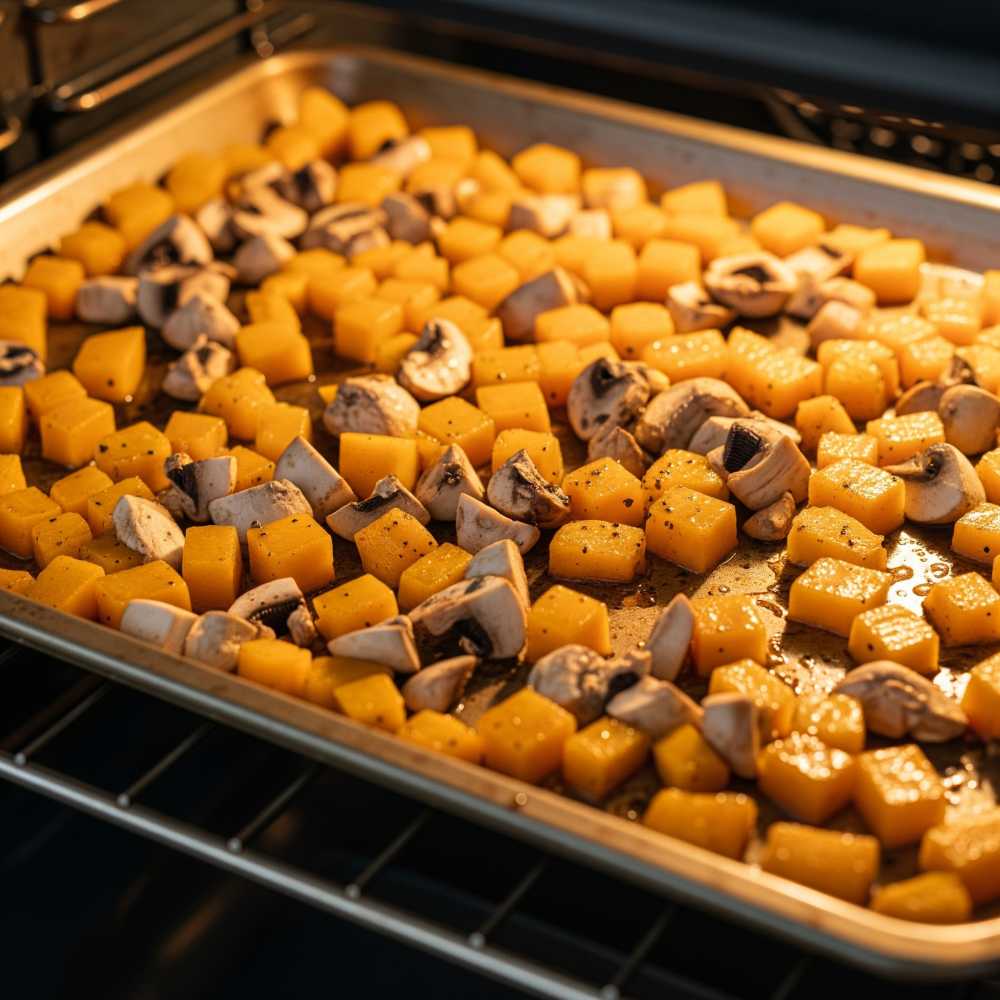
Step 2: Build the Base with Aromatics
In a large pot, sauté Shallot and garlic in olive oil over medium heat. You want them soft and golden, not scorched. That sweetness from slow-sauteed onion is essential—it smooths the transition between squash and mushroom.
Step 3: Combine & Simmer
Add your roasted vegetables to the pot. Pour in vegetable broth—just enough to cover. Add fresh or dried thyme now, not before, so it steeps properly. Simmer gently for about 10–15 minutes, lid slightly ajar.
Chef’s Note: Don’t rush this part. This is when flavors marry. It’s not about “cooking” the ingredients anymore—it’s about cohesion.
Step 4: Blend to Desired Texture
Now comes your fork-in-the-road moment.
- For a completely creamy soup, use an immersion blender directly in the pot or transfer to a high-speed blender in batches.
- If you’re like me and enjoy some chew in your spoon, reserve a few roasted mushroom slices before blending and stirring them in at the end.
Either way, blend until smooth. No grittiness, no fibrous chunks. If it’s too thick, thin it with broth by the tablespoon.
Step 5: Finish with Creaminess
Stir in coconut milk or your cream of choice after the heat has been removed. Don’t boil after this point—it can split or dull the flavor. Taste and adjust salt, pepper, and acid (a splash of lemon juice can brighten it if needed).
More Recipes to checkout:
Final Adjustments
Here’s where experience matters:
- If it tastes sweet but flat, add acidity—such as lemon juice or a tiny splash of apple cider vinegar.
- If it tastes thin, reduce it gently on the stove.
- If the flavor’s muted, it’s often a salt issue—especially with homemade broth.

Roasted Butternut Squash Mushroom Soup (Creamy & Vegan)
Equipment
- Chef's knife
- Cutting board
- Large baking sheet
- Parchment paper
- Large soup pot
- Wooden spoon or spatula
- Immersion blender or high-speed blender
- Measuring cups and spoons
Ingredients
- 1 medium butternut squash peeled and cubed (about 3 cups)
- 2 cups mushrooms cremini and/or oyster, sliced
- 2 tablespoons olive oil plus more for roasting
- 1 small shallot finely chopped
- 2 garlic cloves minced
- 1 teaspoon dried thyme or 1 tablespoon fresh thyme
- 3 to 4 cups vegetable broth adjust for consistency
- ½ cup full-fat coconut milk or cashew cream
- Salt and freshly ground black pepper to taste
- Optional: smoked paprika lemon juice (for brightness)
Instructions
- Preheat Oven: Set oven to 400°F (200°C). Line a baking sheet with parchment paper.
- Roast Vegetables: Toss butternut squash cubes and mushroom slices with olive oil, salt, pepper, and optional thyme or smoked paprika. Spread evenly on the baking sheet with space between pieces. Roast for 25–30 minutes, until squash edges are caramelized and mushrooms are browned and shrunken.
- Sauté Aromatics: In a large soup pot, heat 2 tbsp olive oil over medium heat. Add shallot and garlic, sauté until soft and translucent (about 3–5 minutes). Avoid browning.
- Combine & Simmer: Add roasted vegetables to the pot. Pour in vegetable broth until the vegetables are just covered. Add thyme. Simmer gently for 10–15 minutes with the lid slightly ajar.
- Blend the Soup: Remove a few mushroom slices if you'd like some texture later. Use an immersion blender directly in the pot or transfer in batches to a blender. Blend until completely smooth. Adjust thickness with more broth if needed.
- Add Cream & Final Adjustments: Off the heat, stir in the coconut milk (or preferred vegan cream). Taste and adjust seasoning. Add a splash of lemon juice for brightness if desired. Do not boil after adding cream.
- Serve: Ladle into bowls. Optionally garnish with reserved roasted mushrooms, herbs, or a swirl of coconut cream.
Notes
- Don’t soak mushrooms—wipe them clean to avoid sogginess.
- Roasting is key to depth; don’t shortcut it.
- For extra protein or texture, add cooked lentils or roasted chickpeas as garnish.
- Cashew cream (¼ cup soaked cashews blended with ¼ cup water) is a great neutral alternative to coconut milk.
- Soup stores well refrigerated for up to 4 days and freezes beautifully for 2–3 months.

